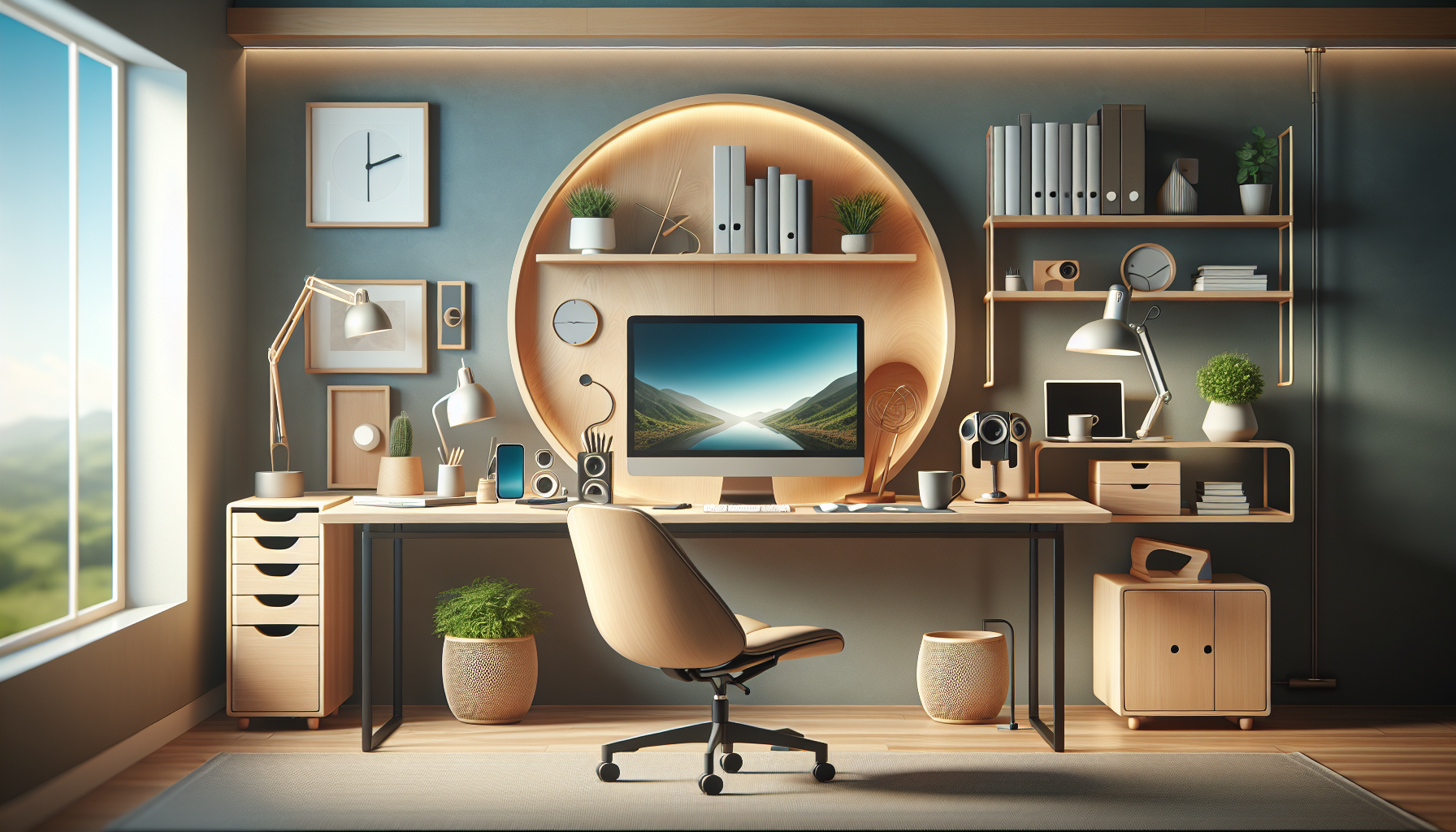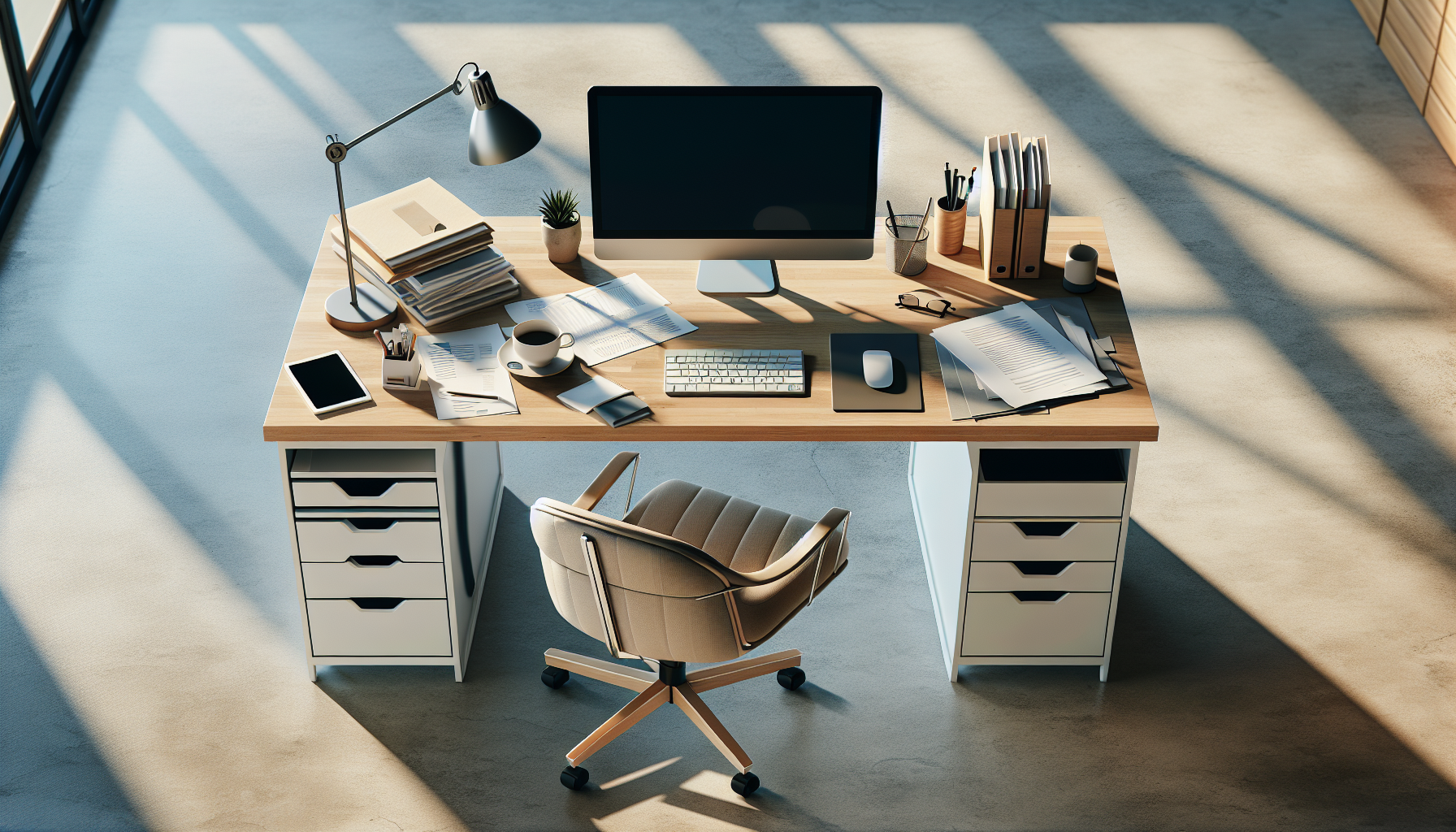Setting up a home workstation can be a daunting task, especially if you’re new to working remotely. It’s important to create a comfortable and productive space that allows you to stay focused and organized. From choosing the right desk and chair to organizing your technology and optimizing your workspace, this article will guide you through the process of setting up an efficient home workstation that supports your work-from-home journey. So, whether you’re a freelancer, a remote worker, or just looking to create a dedicated space for your personal projects, read on to discover helpful tips and tricks to set up the perfect home workstation.

Choosing the Right Location
Finding the perfect location for your home workstation is crucial for creating a productive and comfortable work environment. Dedicate a specific area in your home as your work area, separate from your living or recreation spaces. This will help you mentally separate your work life from your personal life. Consider a room with a door that you can close to minimize distractions and interruptions.
When selecting your work area, take into account the availability of natural lighting. Natural light can have a positive impact on your mood and productivity. Choose a spot near a window where you can enjoy the benefits of sunlight. However, make sure to position your workstation in a way that avoids direct glare on your monitor, as this can cause eye strain.
In addition to natural lighting, it’s important to consider the overall lighting in your selected area. Make sure it provides sufficient illumination for your work tasks. If necessary, invest in task lighting to ensure adequate lighting on your workspace.
Proper ventilation is another crucial factor to keep in mind. Ensure that your chosen location has good airflow and ventilation to prevent stuffiness and enhance air quality. This will contribute to a comfortable and healthy working environment.
Selecting the Right Furniture
Choosing the right furniture for your home workstation is essential for maintaining good posture and reducing strain on your body. Start with an ergonomic chair that provides proper support to your back, neck, and arms. Look for a chair with adjustable features, such as seat height, backrest angle, and armrest height. This will allow you to customize the chair to suit your body and working preferences.
A suitable desk is equally important. Opt for a desk that is spacious enough to accommodate your computer, documents, and other necessary items. The desk should be at an appropriate height, allowing your arms to rest comfortably on the surface. Consider a standing desk if you prefer to switch between sitting and standing during your workday.
An adjustable monitor stand is another essential piece of furniture. Position your monitor at eye level to prevent strain on your neck and avoid slouching. Adjustability is key, as it allows you to find the optimal height and angle for your specific needs.
Don’t forget about your keyboard and mouse! Look for ergonomic options that promote a neutral wrist position, reducing the risk of repetitive strain injuries. Consider keyboards and mice that have wrist support or are split into separate sections to minimize muscle strain.
Setting Up an Ergonomic Workstation
Once you have your furniture in place, it’s crucial to set up your workstation in an ergonomic manner. Maintaining proper posture is essential for preventing musculoskeletal issues and enhancing productivity.
Keep your back straight and your shoulders relaxed. Position your monitor directly in front of you, at eye level. This will ensure that you don’t have to strain your neck or slouch to see the screen.
Adjust your chair height so that your feet are flat on the floor and your knees are at a 90-degree angle. The armrests should be at a height that allows your elbows to rest comfortably, reducing strain on your shoulders and arms.
Using ergonomic keyboards and mice can also greatly contribute to your comfort and productivity. These tools are designed to reduce strain on your wrists and fingers, allowing for a more natural and comfortable typing experience.
Organizing Your Workstation
A clean and well-organized workstation can enhance your efficiency and help you stay focused. Start by managing your cables. Use cable management solutions to keep your cords neatly organized and out of your way. This will prevent them from tangling and causing unnecessary distractions.
Keep your desk clutter-free by having designated spaces for your essential items. Utilize drawers, shelves, or organizers to store your documents, pens, notepads, and other supplies. This will save you time and frustration by ensuring that everything you need is within easy reach.
Consider using storage solutions that are both practical and visually appealing. Choose bins or boxes that fit your aesthetic preferences while providing functional storage. A tidy and organized workspace can contribute to a calmer and more focused mindset.
Ensuring Proper Lighting
Proper lighting is crucial for a comfortable and productive workspace. Insufficient lighting can strain your eyes and negatively impact your mood and focus. On the other hand, excessive glare can cause eye fatigue and headaches. Finding the right balance is key.
Make sure your work area is well-lit with sufficient general lighting. Avoid relying solely on dim or harsh overhead lighting, as it can create uncomfortable shadows or reflections on your monitor. Ideally, use a combination of ambient lighting, such as ceiling lights, and task lighting, such as desk lamps, to provide adequate illumination across your workspace.
To avoid glare on your monitor, position it perpendicular to any windows or bright light sources. Consider using a glare-reducing screen or an anti-glare filter to further minimize glare and reflections.
Take advantage of natural lighting if it’s available in your workspace. Natural light can boost your mood and energy levels. However, make sure to position your workstation in a way that avoids direct sunlight on your monitor, as this can cause difficulties in reading and lead to eye strain.
Evaluating Technology Needs
Choosing the right technology for your home workstation is crucial for seamless workflow and efficient communication. Start with selecting a computer that meets your specific requirements for processing power and storage capacity. Consider factors such as the nature of your work tasks and the software applications you need to use.
Alongside a reliable computer, make sure you have a stable and fast internet connection. Research and select an appropriate internet service provider that offers the speed and reliability you need for your work. A slow or unreliable internet connection can greatly hinder your productivity and communication with colleagues or clients.
Don’t forget to determine the necessary accessories for your workstation. This can include printers, scanners, external hard drives, docking stations, and other peripherals depending on your work requirements. Make a list of the accessories you need and ensure they are compatible with your computer and other devices.
If your work involves audio or video conferences, setting up the right audio and video equipment is essential. Invest in a quality microphone and webcam, or consider using a headset with a built-in microphone for clear communication. Test the equipment beforehand to ensure it functions properly and troubleshoot any issues.
Connecting to Power and Network
To ensure uninterrupted workflow, it’s important to address power and network connectivity in your home workstation setup. Make sure you have easily accessible power outlets near your work area. This will allow you to connect and charge your devices without the hassle of tangled cables or limited reach.
To protect your valuable equipment from power surges or voltage fluctuations, invest in a reliable surge protector. This will safeguard your devices and prevent potential damage caused by power surges during electrical storms or accidents.
Consider whether a wired or wireless network connection best suits your needs. Wired connections generally offer more stability and faster speeds, especially for tasks that require large file transfers or online meetings. However, if you need the flexibility to work from different areas of your home, a wireless connection might be more suitable.
Once you have your network connection established, test its speed to ensure it meets your requirements. Run a speed test to check the upload and download speeds, as they can directly impact your ability to transfer files, join meetings, or access online resources efficiently.
Creating a Comfortable Work Environment
A comfortable work environment is essential for maintaining focus and productivity. Temperature control plays a significant role in creating a comfortable workspace. Make sure your work area is adequately heated during colder months and well-ventilated during warmer months. Consider using fans, heaters, or air conditioning to regulate the temperature based on your preferences and the weather.
Appropriate humidity levels are also important for your comfort and well-being. Dry air can cause discomfort and dry out your skin and eyes. Use a humidifier to add moisture to the air if you live in a dry climate or during winter months when indoor heating can cause dryness.
Background noise can be a major distraction, especially if you live in a noisy environment or have family members or pets around. Minimize background noise by using noise-cancelling headphones or playing soft background music to create a more focused and peaceful atmosphere.
Personalize your space to make it your own. Surround yourself with items that inspire and motivate you, such as artwork, plants, or meaningful mementos. A personalized work environment can enhance your mood and make your workspace feel more inviting and enjoyable.
Setting Up Dual Monitors
If your work requires multitasking or managing multiple applications simultaneously, setting up dual monitors can greatly enhance your efficiency. Start by choosing monitors that meet your display and resolution preferences. Consider factors such as screen size, resolution, and connectivity options.
Check the video output ports on your computer to ensure compatibility with dual monitors. Common video output ports include HDMI, DisplayPort, and VGA. If your computer has multiple ports, ensure you have the necessary cables or adapters to connect your monitors.
Once you have your monitors connected, adjust the display settings to optimize the layout and arrangement. Configure the screens to extend your desktop rather than duplicating it. This allows you to seamlessly move windows and applications between the two screens. Adjust the resolution and scaling settings to ensure a consistent and comfortable visual experience across both monitors.
Organize your dual monitor layout based on your work tasks and preferences. Position the monitors in a way that minimizes neck and eye strain. Consider placing the main screen directly in front of you and the secondary screen to the side, creating a comfortable viewing environment.
Considering Privacy and Security
Protecting your privacy and ensuring the security of your home workstation are vital. If you work with sensitive information or need to prevent others from viewing your screen, invest in a privacy screen. These screens limit the viewing angle, making it difficult for people around you to see what’s on your monitor.
Both physical and digital security measures are essential. Physically secure your workspace by locking your office or using cabinet locks to protect documents or equipment. Implement password protection on your devices, use strong and unique passwords, and enable two-factor authentication whenever possible. Regularly update your software and use reputable antivirus and malware protection software to safeguard your workstation against cyber threats.
Maintaining a secure network connection is equally important. Use encryption protocols such as WPA2 for your wireless network to prevent unauthorized access. Regularly update your router’s firmware and change the default login credentials to enhance security.
Protecting your workstation from malware is crucial for maintaining the integrity of your work and data. Install reliable antivirus software and regularly perform scans to detect and remove any potential threats. Be cautious when opening emails or downloading files from unknown sources to minimize the risk of malware infiltrating your system.
Setting up a home workstation may seem overwhelming at first, but with careful consideration and planning, you can create a productive and comfortable workspace that suits your needs. Follow these guidelines and tailor them to your specific requirements to ensure a successful transition to working from home.
